Keysight N1092 Series sampling oscilloscope summary
The Keysight N1092 Series is a high-performance photoelectric signal sampling oscilloscope that delivers high sensitivity, throughput, accuracy, and compact design. It features an optical channel that can support 28/45 GHz bandwidth, as well as an optional CDR for clock recovery and data analysis. It can also be combined with other N1090A series optical and electrical channels to meet different testing needs.
Key Features:
• High sensitivity: Optical signals below -15 dBm can be measured without the need for any external amplifier or attenuator.
• High throughput: Enables fast data acquisition and analysis, processing more than 10 million waveforms per second.
• High accuracy: Provides up to 0.5 ps temporal resolution and up to 0.1 dB amplitude resolution.
• Compact design: Occupies only one 3U rack space, saving space and cost in the lab.
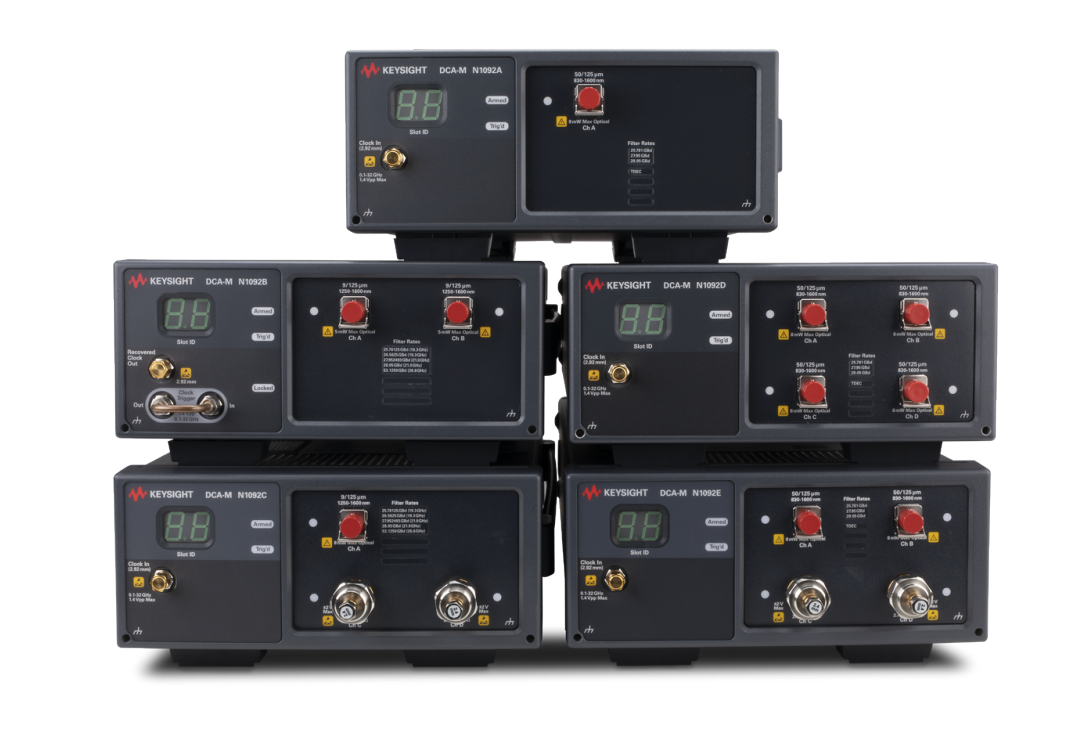
Keysight N1092 Series Accessories:
• Fiber optic connectors: Support multiple types of fiber optic connectors such as FC/PC, FC/APC and LC/PC.
• Fiber optic cable: Requires a single-mode fiber optic cable to connect the light source and optical probe.
• Optical probes: Can be used with many types of optical probes, such as N1021B, N1023B, and N1024B.
• Power cord: Use a standard AC power cord to connect to the power supply.
Keysight N1092 Series Software:
• FlexDCA Software: Software designed for the N1090A Series that enables waveform display, measurement, analysis, and reporting.
• FlexDCA Remote Interface Software: This is software that can remotely control the N1090A Series and can connect PCs and oscilloscopes via LAN, GPIB or USB.
• PAM-N Analysis Software: Software that analyzes PAM-4 and NRZ signals and provides functions such as eye diagram, eye mask, eye contour, eye diagram parameters, histogram, TDECQ, and BER.
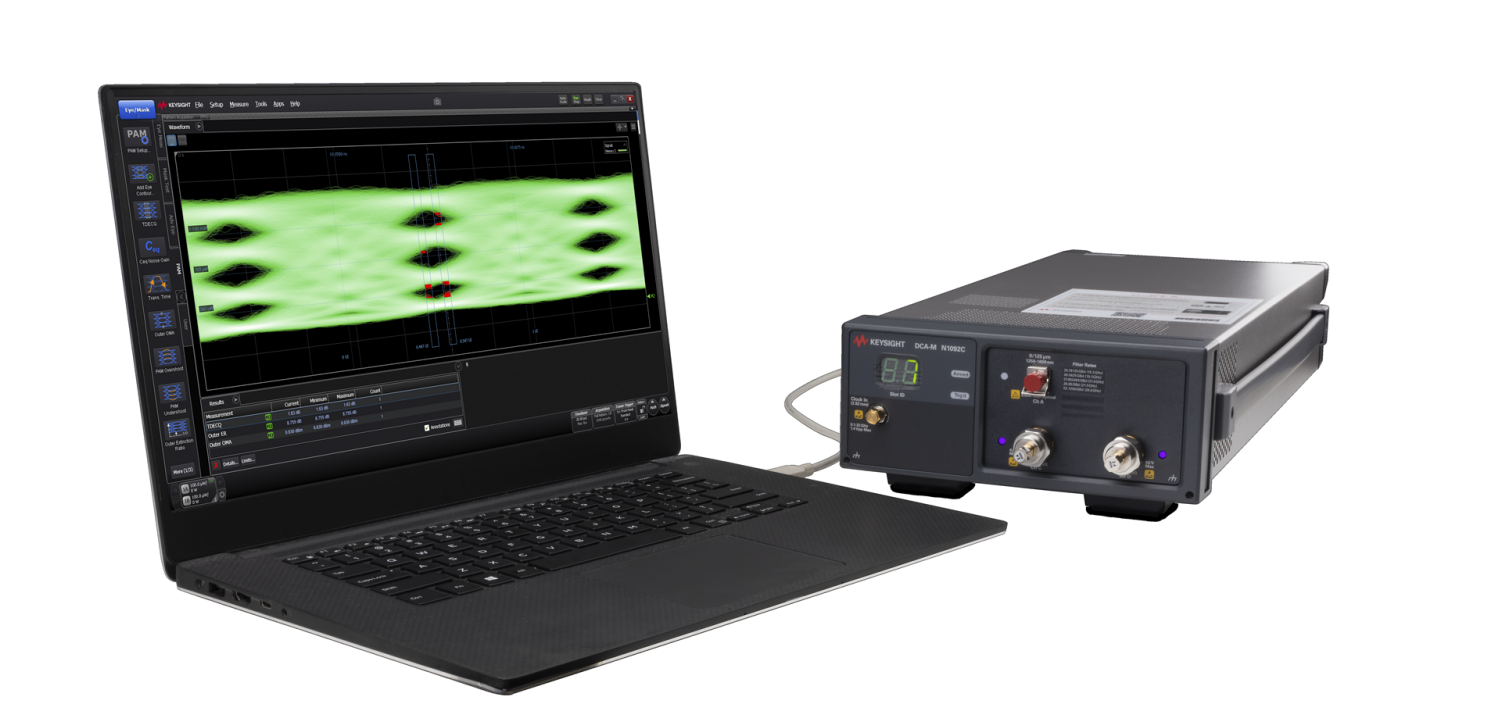
What models are available in the Keysight N1092 series?
• N1092A: A DCA-M sampling oscilloscope with one optical channel and two electrical channels. The N1092A is suitable for verifying that optical transmitters comply with communication standards. The optical channel bandwidth is 40 GHz (Option 40A) and the electrical channel bandwidth is 30 GHz.
• N1092B: A DCA-M sampling oscilloscope with one optical channel and two electrical channels. The N1092B is suitable for verifying that optical transmitters comply with communication standards. The optical channel bandwidth is 40 GHz (option 40A) and the electrical channel bandwidth is 50 GHz.
• N1092C: A DCA-M sampling oscilloscope with one optical channel and two electrical channels. The N1092C is suitable for verifying that optical transmitters comply with communication standards. The optical channel bandwidth is >40 GHz (option 40A) and the electrical channel bandwidth is 50 GHz.
• N1092D: A DCA-M sampling oscilloscope with two optical channels and two electrical channels. The N1092D is suitable for verifying that optical transmitters comply with communication standards. The optical channel bandwidth is >40 GHz (option 40A) and the electrical channel bandwidth is 50 GHz.
• N1092E: A DCA-M sampling oscilloscope with four optical channels and two electrical channels. The N1092E is suitable for verifying that optical transmitters comply with communication standards. The optical channel bandwidth is >40 GHz (option 40A) and the electrical channel bandwidth is 50 GHz.
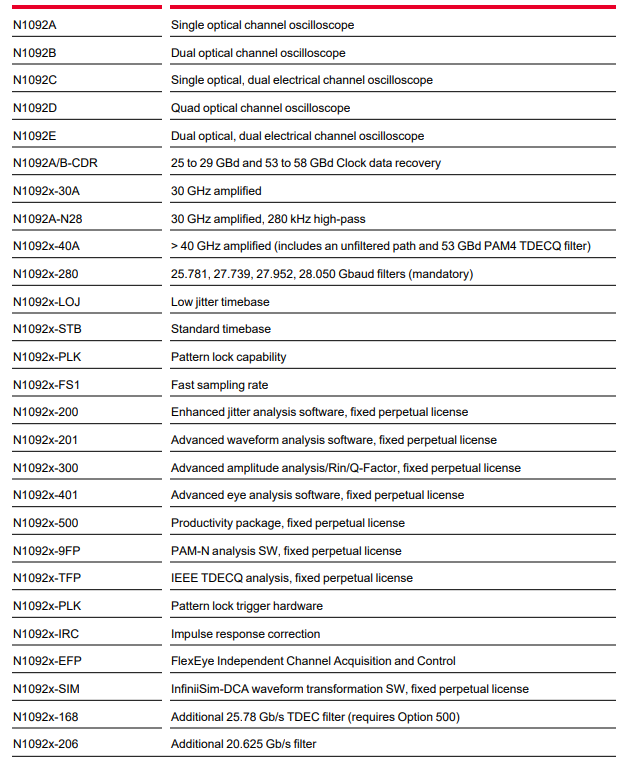

Keysight N1092 Series Application Scenarios:
• Test optical transmitter: measure and analyze the output signal of the optical transmitter, such as wavelength, power, spectrum, modulation quality, eye diagram, etc.
• Test optical receiver: measure and analyze the input signal of the optical receiver, such as sensitivity, dynamic range, bit error rate, etc.
• Test optical module: measure and analyze the performance of optical module, such as insertion loss, crosstalk, dispersion, polarization, etc.
• Test optical interconnect: measure and analyze the transmission efficiency of optical interconnect, such as attenuation, reflection, refraction, phase, etc.
What optical communication systems and components can be tested by the Keysight N1092 Series?
• High-speed optical communication systems from 8.4 to 64 Gbaud, including PAM-4 waveforms.
• Multimode and singlemode optical signals at wavelengths from 750 nm to 1630 nm.
• Eye diagram, extinction ratio, jitter, waveform parameters, etc. of optical transmitter.
• Impulse response, sensitivity, RIN, etc. of optical receiver.
What accessories to buy to use the Keysight N1092 series?
• USB cable (for connecting DCA-X host or user's PC). This accessory is already included in the product and does not need to be purchased additionally.
• Power cord. This accessory is also included in the N1092A product and does not need to be purchased additionally.
• Instrument cover. This accessory is also included in the N1092A product and does not need to be purchased additionally.
• FlexDCA software. This software is necessary for controlling and analyzing the N1092A, which you can find on the official product page.
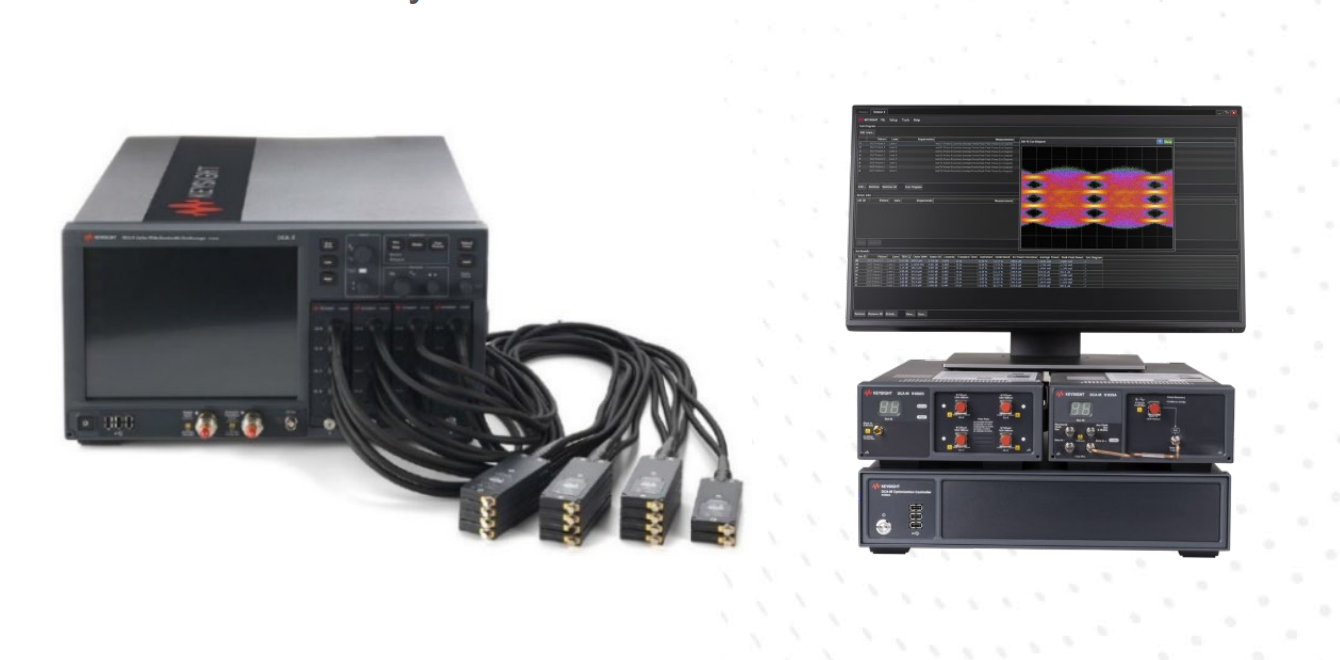
What is the difference between N1092A and N1090A series:
• The N1092A has a higher data rate range and can support measurements from 20 Gb/s to 53 GBaud, while the N1090A has a data rate range of 1 Gb/s to 10 Gb/s.
• The N1092A has lower noise as low as 4 μW and the N1090A has as low noise as low as 1 μ. This means that the N1092A can provide higher dynamic measurement range and sensitivity, making it ideal for PAM-4 waveform analysis.
• The N1092A has a wider channel bandwidth of up to 30 GHz and 50 GHz, while the N1090A has a channel bandwidth of 20 GHz. This improves the measurement accuracy and resolution of electrical signals.
• The N1092A can be selected from PLK and IRC options for pattern lock triggering and impulse response calibration, extending its data rate range and reference receiver functionality. The N1090A does not support these options or measurements that require a pattern-locked clock.
How to use the sampling oscilloscope FlexDCA software for simulation analysis
1. Open the FlexDCA software and select File>Open>Simulation Data, or click the Simulation Data icon on the toolbar.
2. In the pop-up dialog box, select the simulation data file you want to import, or enter a file name and path. You can import multiple files and view and select different data sources in the Data Source list.
3. Click OK and the FlexDCA software will automatically load and display the waveform of the simulation data you selected. You can view and adjust the waveform's display settings such as zoom, offset, grid, marker, and more in the Waveform View window.
4. In the Measurement View window, you can select and execute different measurement functions and analysis tools, such as eye diagram template, extinction ratio, jitter analysis, waveform conversion, etc. You can view the measurement results in the Measurement Results window and adjust the measurement parameters in the Measurement Setup window.
5. If you want to export or save your simulation results, you can select File>Export>Waveform Data or File>Save As, and select the appropriate format and location.
What operating system platforms does FlexDCA support?
The following operating systems are supported:
Windows 11 (supported in A.07.40 and above)
Windows 10 (supported in A.05.00 and above)
Windows 7 64-bit (supported in A.05.00 and above, but will end of support in October 2023)
Used by Keysight FlexDCA
Keysight FlexDCA is available as a new user interface for N1000A DCA-X, DCA-M, or independent clock recovery. It can be used to test and validate high-speed optical communication systems and components, including PAM-4 waveforms. It can run on a DCA-X host or the user's personal computer and connect to DCA-M using a USB cable.
FlexDCA can control the 86100C or 86100D over a LAN connection, or run in offline mode using saved waveforms or the built-in waveform simulator. It also provides de-embedding and embedding capabilities, as well as measurement tools such as jitter analysis, waveform analysis, amplitude analysis, phase-locked loop measurement, and more. FlexDCA also supports a variety of compliance testing applications such as OIF CEI 3.1, IEEE 802.3 (Ethernet), SFF-8431 (SFP+), and more
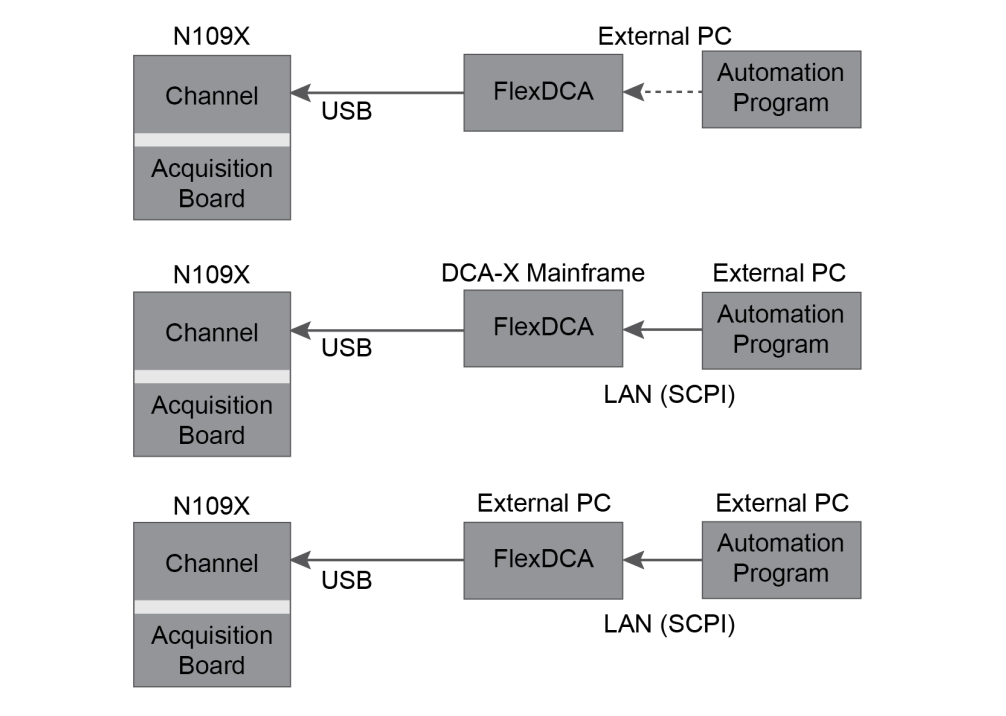
The Keysight N1092 Series is a high-performance photoelectric signal sampling oscilloscope that delivers high sensitivity, throughput, accuracy, and compact design. It features an optical channel that can support 28/45 GHz bandwidth, as well as an optional CDR for clock recovery and data analysis. It can also be combined with other N1090A series optical and electrical channels to meet different testing needs.
Key Features:
• High sensitivity: Optical signals below -15 dBm can be measured without the need for any external amplifier or attenuator.
• High throughput: Enables fast data acquisition and analysis, processing more than 10 million waveforms per second.
• High accuracy: Provides up to 0.5 ps temporal resolution and up to 0.1 dB amplitude resolution.
• Compact design: Occupies only one 3U rack space, saving space and cost in the lab.

Keysight N1092 Series Accessories:
• Fiber optic connectors: Support multiple types of fiber optic connectors such as FC/PC, FC/APC and LC/PC.
• Fiber optic cable: Requires a single-mode fiber optic cable to connect the light source and optical probe.
• Optical probes: Can be used with many types of optical probes, such as N1021B, N1023B, and N1024B.
• Power cord: Use a standard AC power cord to connect to the power supply.
Keysight N1092 Series Software:
• FlexDCA Software: Software designed for the N1090A Series that enables waveform display, measurement, analysis, and reporting.
• FlexDCA Remote Interface Software: This is software that can remotely control the N1090A Series and can connect PCs and oscilloscopes via LAN, GPIB or USB.
• PAM-N Analysis Software: Software that analyzes PAM-4 and NRZ signals and provides functions such as eye diagram, eye mask, eye contour, eye diagram parameters, histogram, TDECQ, and BER.

What models are available in the Keysight N1092 series?
• N1092A: A DCA-M sampling oscilloscope with one optical channel and two electrical channels. The N1092A is suitable for verifying that optical transmitters comply with communication standards. The optical channel bandwidth is 40 GHz (Option 40A) and the electrical channel bandwidth is 30 GHz.
• N1092B: A DCA-M sampling oscilloscope with one optical channel and two electrical channels. The N1092B is suitable for verifying that optical transmitters comply with communication standards. The optical channel bandwidth is 40 GHz (option 40A) and the electrical channel bandwidth is 50 GHz.
• N1092C: A DCA-M sampling oscilloscope with one optical channel and two electrical channels. The N1092C is suitable for verifying that optical transmitters comply with communication standards. The optical channel bandwidth is >40 GHz (option 40A) and the electrical channel bandwidth is 50 GHz.
• N1092D: A DCA-M sampling oscilloscope with two optical channels and two electrical channels. The N1092D is suitable for verifying that optical transmitters comply with communication standards. The optical channel bandwidth is >40 GHz (option 40A) and the electrical channel bandwidth is 50 GHz.
• N1092E: A DCA-M sampling oscilloscope with four optical channels and two electrical channels. The N1092E is suitable for verifying that optical transmitters comply with communication standards. The optical channel bandwidth is >40 GHz (option 40A) and the electrical channel bandwidth is 50 GHz.


Keysight N1092 Series Application Scenarios:
• Test optical transmitter: measure and analyze the output signal of the optical transmitter, such as wavelength, power, spectrum, modulation quality, eye diagram, etc.
• Test optical receiver: measure and analyze the input signal of the optical receiver, such as sensitivity, dynamic range, bit error rate, etc.
• Test optical module: measure and analyze the performance of optical module, such as insertion loss, crosstalk, dispersion, polarization, etc.
• Test optical interconnect: measure and analyze the transmission efficiency of optical interconnect, such as attenuation, reflection, refraction, phase, etc.
What optical communication systems and components can be tested by the Keysight N1092 Series?
• High-speed optical communication systems from 8.4 to 64 Gbaud, including PAM-4 waveforms.
• Multimode and singlemode optical signals at wavelengths from 750 nm to 1630 nm.
• Eye diagram, extinction ratio, jitter, waveform parameters, etc. of optical transmitter.
• Impulse response, sensitivity, RIN, etc. of optical receiver.
What accessories to buy to use the Keysight N1092 series?
• USB cable (for connecting DCA-X host or user's PC). This accessory is already included in the product and does not need to be purchased additionally.
• Power cord. This accessory is also included in the N1092A product and does not need to be purchased additionally.
• Instrument cover. This accessory is also included in the N1092A product and does not need to be purchased additionally.
• FlexDCA software. This software is necessary for controlling and analyzing the N1092A, which you can find on the official product page.

What is the difference between N1092A and N1090A series:
• The N1092A has a higher data rate range and can support measurements from 20 Gb/s to 53 GBaud, while the N1090A has a data rate range of 1 Gb/s to 10 Gb/s.
• The N1092A has lower noise as low as 4 μW and the N1090A has as low noise as low as 1 μ. This means that the N1092A can provide higher dynamic measurement range and sensitivity, making it ideal for PAM-4 waveform analysis.
• The N1092A has a wider channel bandwidth of up to 30 GHz and 50 GHz, while the N1090A has a channel bandwidth of 20 GHz. This improves the measurement accuracy and resolution of electrical signals.
• The N1092A can be selected from PLK and IRC options for pattern lock triggering and impulse response calibration, extending its data rate range and reference receiver functionality. The N1090A does not support these options or measurements that require a pattern-locked clock.
How to use the sampling oscilloscope FlexDCA software for simulation analysis
1. Open the FlexDCA software and select File>Open>Simulation Data, or click the Simulation Data icon on the toolbar.
2. In the pop-up dialog box, select the simulation data file you want to import, or enter a file name and path. You can import multiple files and view and select different data sources in the Data Source list.
3. Click OK and the FlexDCA software will automatically load and display the waveform of the simulation data you selected. You can view and adjust the waveform's display settings such as zoom, offset, grid, marker, and more in the Waveform View window.
4. In the Measurement View window, you can select and execute different measurement functions and analysis tools, such as eye diagram template, extinction ratio, jitter analysis, waveform conversion, etc. You can view the measurement results in the Measurement Results window and adjust the measurement parameters in the Measurement Setup window.
5. If you want to export or save your simulation results, you can select File>Export>Waveform Data or File>Save As, and select the appropriate format and location.
What operating system platforms does FlexDCA support?
The following operating systems are supported:
Windows 11 (supported in A.07.40 and above)
Windows 10 (supported in A.05.00 and above)
Windows 7 64-bit (supported in A.05.00 and above, but will end of support in October 2023)
Used by Keysight FlexDCA
Keysight FlexDCA is available as a new user interface for N1000A DCA-X, DCA-M, or independent clock recovery. It can be used to test and validate high-speed optical communication systems and components, including PAM-4 waveforms. It can run on a DCA-X host or the user's personal computer and connect to DCA-M using a USB cable.
FlexDCA can control the 86100C or 86100D over a LAN connection, or run in offline mode using saved waveforms or the built-in waveform simulator. It also provides de-embedding and embedding capabilities, as well as measurement tools such as jitter analysis, waveform analysis, amplitude analysis, phase-locked loop measurement, and more. FlexDCA also supports a variety of compliance testing applications such as OIF CEI 3.1, IEEE 802.3 (Ethernet), SFF-8431 (SFP+), and more








